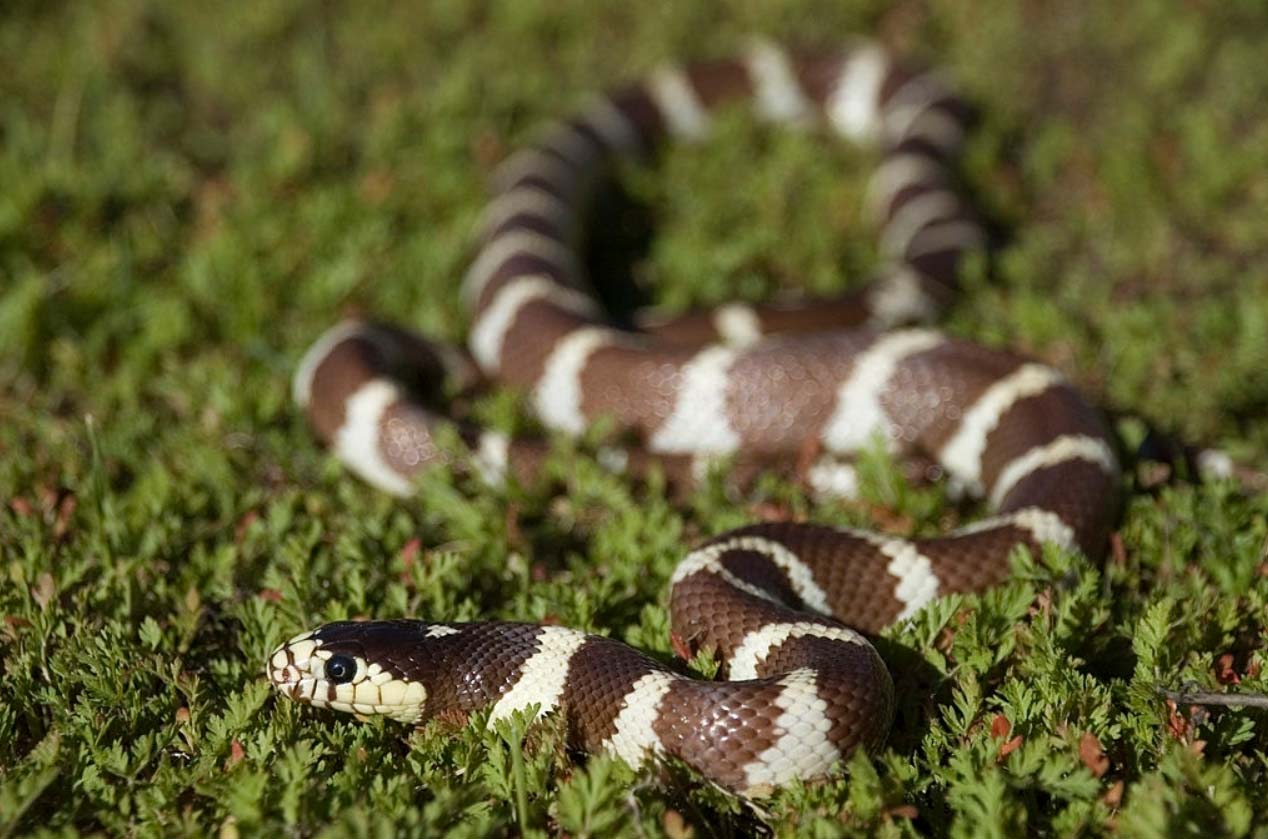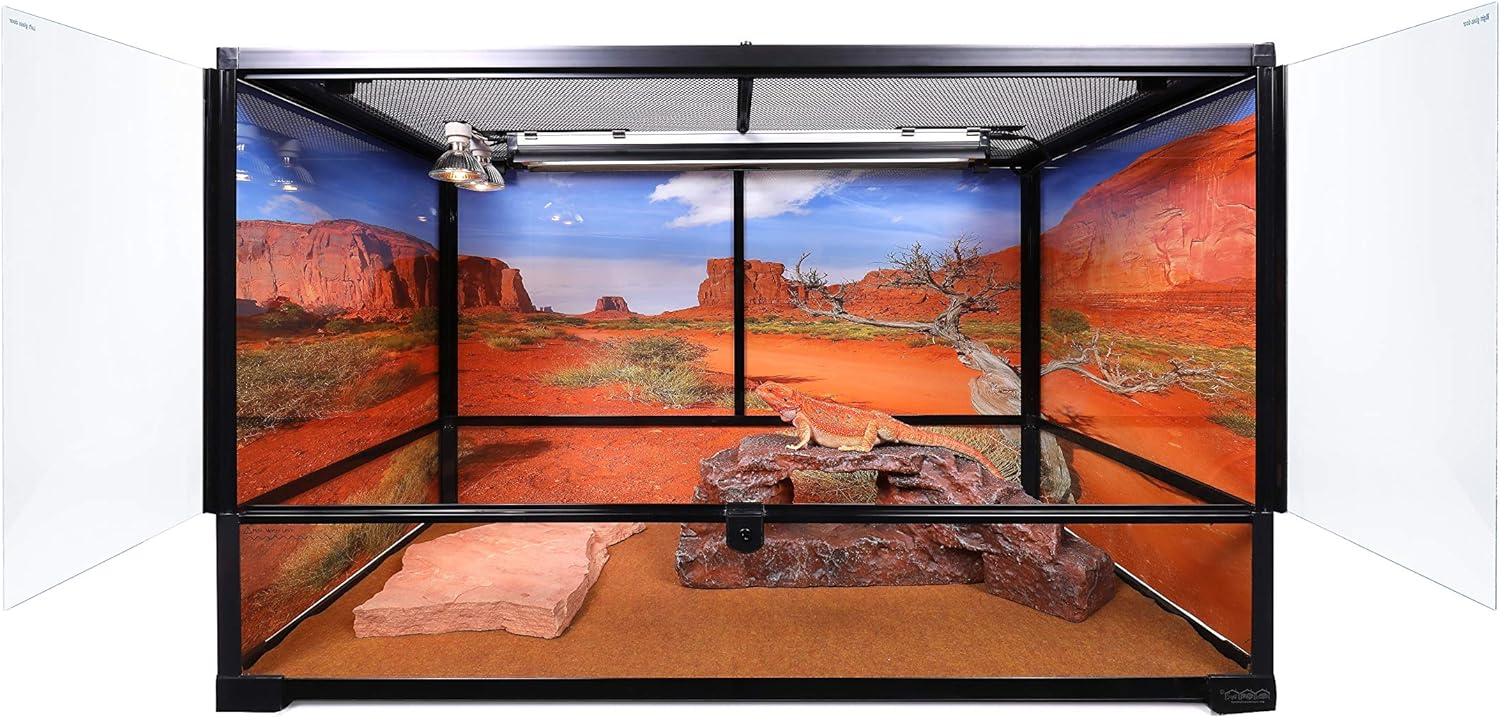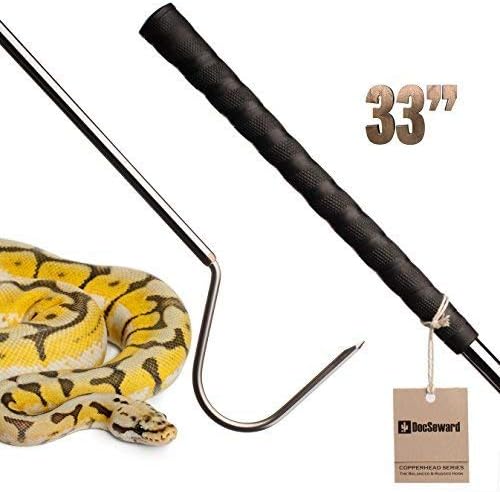The California kingsnake is a great snake for beginners because of its calm temperament and unique personality.
Their scientific name, Lampropeltis getulus californiae, means shiny scales after their striking appearance.
Many people call these snakes “king snakes”, however, the correct way to write their name is “kingsnake”.
The California kingsnake is indigenous to the west coast of North America: California, Baja, Nevada, Arizona, Utah, Oregon, and Mexico.
However, they can be found as pets all over the world!
Although they like to “rattle” their tales as a rattlesnake does, they are non-venomous.
Cali Kings actively stalk their prey in the wild and then suffocate them via constriction.
Reptile Overview
| Common name: | California kingsnake, California king snake, Californian Kings, Cali Kings |
| Scientific name: | Lampropeltis getulus californiae |
| Indigenous: | Parts of North America |
| Natural habitat: | Desert to dry coastal |
| Endangered status: | Not listed |
| Maturity: | Three to four years |
| Experience level: | Beginner |
Behavior and Temperament
Cali Kings make great pets because they are docile if raised right. They each have their own personality and it is possible to form a bond with your snake through careful handling and patience.
While they are calm around humans, they are aggressive towards other snakes and reptiles. They should never be housed with other snakes.
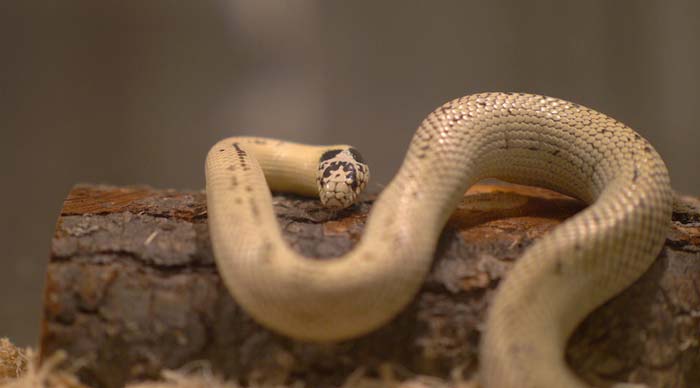
They are known to cannibalize and eat their own kind as well as other species of snake.
Breeding time should be the only time two Cali Kings come into contact with each other.
These snakes are most often diurnal creatures. This means that they are active during the day.
However, some California kingsnakes can be nocturnal, which means they are active at night. If your Cali King displays nocturnal or crepuscular behavior, it might be because they are getting too hot during the day.
Lifespan
California kingsnakes can live for 15 to 20 years. Owning one is a long-time commitment.
However, it is so rewarding. Your snake will come to know you and enjoy being held by you if you do it correctly.
Appearance
Captive snakes grow to around three to four feet in length. Wild California kingsnakes can get up to 6 feet long!
Cali Kings have a uniform girth throughout their bodies with a much thinner tail. The head is only slightly larger than the body.
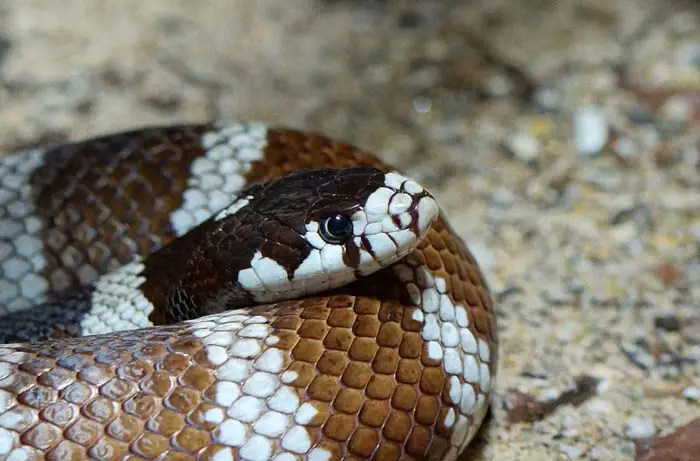
The California kingsnake has a wide variety of colors and patterns on its body. These will usually depend on where the snake originated.
Its most common coloring is alternating bands of dark and light. The dark color is either black or brown and the lighter color is either white or yellow.
However, there are some beautiful color morphs.
The snakes from the south coast of California can have solid dark-colored bodies with light stripes of color running laterally down the spine and sides.
Or they can have solid light-colored bodies with patches of a dark color such as the Banana California kingsnake.
Another unique morph is known as the Ghost morph.
This California kingsnake will have a light pinky/brown or lavender color alternating with a bright white.
The Ghost morph is different from the Albino California kingsnake. An albino will have red eyes and very light pink/yellow coloring.
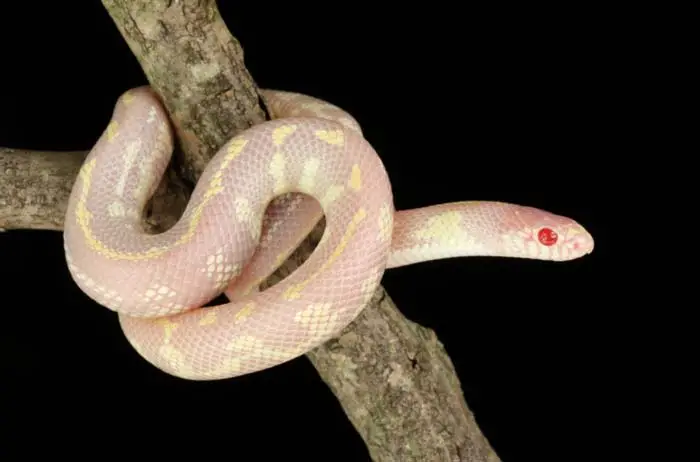
Breeding Cali Kings for specific color morphs can be an interesting process that results in beautiful variations such as the Purple Passion California kingsnake and the Casper Ghost California kingsnake.
Enclosure
The Cali King’s natural habitat ranges from coastal to high altitude mountain desert. The enclosure you use needs to mimic this as closely as possible for your snake’s health.
We would recommend an enclosure no smaller than 10 gallons for juveniles. At a year old you can upgrade the size of their enclosure. An adult’s enclosure should be 36 x 18 inches.
Carolina Custom Cages Terrarium 36x18x24
Make sure your enclosure is long enough for there to be an appropriate temperature gradient. This is crucial to the snake’s health.
If your snake is on the larger side, a larger enclosure would be better, approximately 40 gallons. For average snakes, 20 to 30 gallons is sufficient.
Cali Kings are master escape artists, if there is a weakness in your enclosure, they will exploit it and get out. Make sure the lid/door to the enclosure is secured by a clipped latch or lock at all times.
A wooden enclosure is an option because California kingsnakes do not require high humidity. However, wood can be tricky to keep clean and can develop mold over time.
Glass, plexiglass, or plastic aquariums or terrariums are perfectly fine. Make sure there is a good amount of airflow through the cage, however, this should not disturb the temperature gradient.
Substrate
Your Cali King’s natural habitat is quite dry. Therefore, do not add mulch or other substrates that will increase humidity.
Never use pine or cedar shavings. These types of trees have oils in them that will irritate the snake’s skin and cause respiratory problems.
Newspaper, paper towels, and aspen shavings are perfect. Adding some dry leaves or hay to the enclosure will provide an interesting environment for your kingsnake to explore.
Galapagos Aspen Digs Shavings Bedding
Before adding enrichment materials to your snake’s enclosure, research them first. Any vegetation that contains oils should never be put in the enclosure.
Avoid small shavings as they can be swallowed by the snake.
If you have smaller shavings as substrate, feed your snake in a separate container instead of their enclosure.
This is to avoid the snake accidentally eating substrate.
California kings like to burrow so make sure that there is enough substrate for them to get into/under. This is pretty cool to watch if you have a glass or viewing-terrarium.
Add a sturdy branch or two that runs vertically in your enclosure. Your Cali King will use these for enrichment purposes and to watch the world outside.
Blue Ribbon Driftwood Centerpiece with Plants
You can use PVC pipe or real wood. You should sterilize both with boiling water.
Your California kingsnake’s substrate should be agitated and spot cleaned once a day of droppings.
A full clean should happen every 7-14 days where completely new substrate should be used.
Temperature
California kingsnakes are ectothermic, therefore they rely on external sources of heat to regulate their body temperature.
You need to create a temperature gradient in your enclosure to provide your Cali King with the most comfortable environment to live in.
You should have three thermometers in the enclosure. One in the basking spot, one on the warm side, and one on the coolest side of the enclosure.
Zoo Med Labs Digital Hygrometer and Thermometer
Basking Area
This area is the hottest part of the enclosure. A heat lamp can be used on this side of the enclosure to provide ambient heat.
Make sure it is covered as the snake can become curious and burn itself on the bare bulb.
The basking temperature should be 90°F.
Warm Side
The warm side of the enclosure should be between 85°F and 88°F.
We suggest you use an under-tank heating pad under one-third of the tank. A heating pad warms the enclosure evenly without risking burns to your snake.
VIVOSUN Reptile Heat Mat with Digital Thermostat
Place a hideaway on the warm side of the enclosure. This can be as simple as an overturned shoebox or a hollowed-out log so long that is big enough for your snake.
The hideaway gives your snake some privacy and a place to destress when it needs to be warm.
Cool Side
The coolest side of the enclosure should be between 75°F and 80°F.
This temperature can drop to 72°F at night when the lamp is turned off.
Place a hideaway on the cool side of the enclosure. The hideaway gives your snake some privacy and a place to destress when it needs to cool down.
Lighting
Your kingsnake does not necessarily require special lighting. However, having a UVB light in the enclosure will give your snake added health benefits.
Make sure your light has a protective covering in case it shatters.
Your light should not change the temperature gradient at all. Keep a careful eye on this as the light ages.
Do not place your Cali King’s enclosure in direct sunlight as this can cause your snake to over-heat and die.
Your snake needs a 12/12 light cycle. They need a minimum of 10 hours of darkness to maintain their normal cycles.
Make sure you do not turn their heating pad off; they still need warmth at night.
Put your light and/or heating lamp on a timer so that it turns on and off automatically. Our recommendation is Zilla Digital Timer.
Humidity
The Cali King is a desert and coastal snake so it does not need very high humidity.
A humidity range of 35% to 60% is sufficient. Lightly mist the enclosure in the morning with a spray bottle.
Use the higher end of the range during shedding time to ease the process and make your snake more comfortable.
You might find your snake lying in its water bowl during this time too.
Install a hygrometer to keep careful track of the humidity levels. If the levels are too high your snake could develop respiratory problems.
If they are too low then shedding will be difficult and painful.
Diet
Your snake should have a nonporous water bowl that is big enough to lie in.
Put the water dish on the cooler side of the enclosure.
Make sure that it is deep enough not to spill into the enclosure if the snake goes for a dip. This will increase humidity levels.
Cali Kings drink quite a lot of water so make sure that they have fresh clean water every day.
Make sure you clean the water bowl properly to prevent slime build up as this will negatively impact your snake’s health
Feed your hatchlings every 7 days, your juveniles every 10 days, and your adults every 14 days.
Frozen mice or rats are the best and safest option for your Cali King.
The prey item’s girth should not be larger than one and a half times that of your snake.
Cali Kings have hinged jaws to accommodate slightly larger prey.
Put the frozen prey item in a bowl of hot water to thaw and then serve to the snake. Make sure that the prey is fully thawed and slightly warmer than room temperature.
Do not handle your snake 24 hours before feeding or during feeding.
Do not handle your snake for 48 hours after feeding.
Handling
California kingsnakes are docile creatures and will come to recognize you and build a relationship with you over time.
This is done through gentle and well-timed handling.
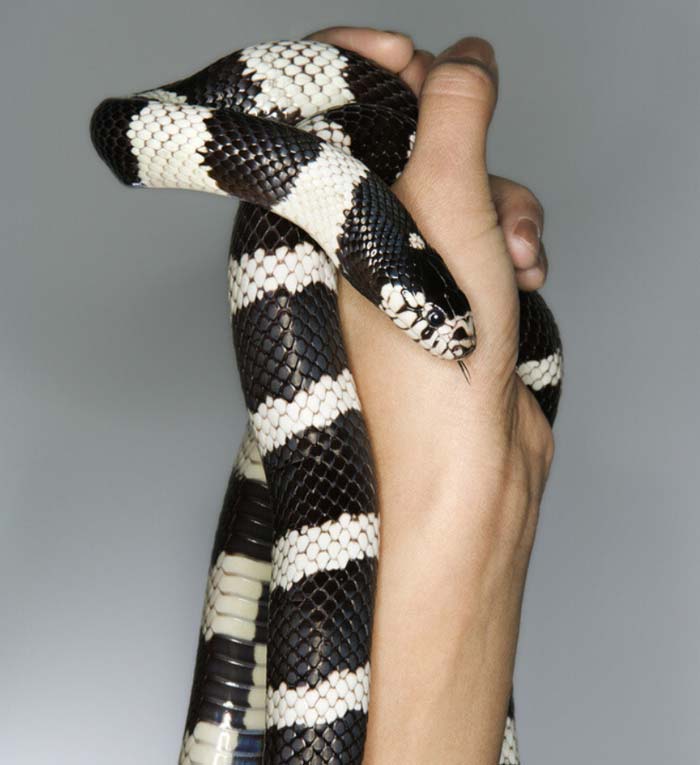
When going to handle your snake you can use two methods:
Scoop
Gently scoop up the snake from its enclosure with your hands.
Do not hold one section of the snake and not support the rest of it as this can harm it and cause a stress response.
Let the snake get used to your hands before progressing.
As it is a naturally curious snake that likes to burrow, it will probably check out your pockets or hood.
Hook
If you are nervous about being bitten, you can hook train your snake.
Using a snake hook, gently nudge the snake to alert it then pick it up using the hook and supporting the body.
Hook training is not necessary with Cali Kings, however, if it makes you feel comfortable then there is no harm.
Avoid touching the top of your snake’s head. Most snakes do not like this and are “head shy”.
They might rear back in freight which can cause the handler to squeeze or drop the snake. This can provoke an attack response or just hurt your snake.
You should not handle your snake for longer than 15 minutes at a time as their core temperature will start to drop.
Avoid handling your snake if it is shedding, Cali Kings can be a little aggressive around this time as shedding can be uncomfortable.
If you go to handle your snake and it shakes its tail at you, similar to how a rattlesnake would but minus the rattle, then it is being defensive.
If your Cali King is in this state, rather leave it alone as it does not want to be handled.
Regular careful handling will help you bond with your snake and provide it with enrichment.
Potential Health Issues
Before bringing your Cali King home, make sure you know of a reliable exotic vet in your area.
If you are a first-time snake owner, you could even take pictures or ask the vet to do a house call to make sure your enclosure setup is correct.
External parasites
Mites are a common issue with snakes. They are small parasites that sit on the snake’s scales and burrow underneath to get at the blood.
They are visible to the naked eye as small black or red dots that move.
A good indication of a mite infestation is if your Cali King is excessively soaking in its water bowl.
Respiratory issues
These issues can be caused by incorrect humidity levels or incorrect substrate. Make sure that your hygrometer is working and the humidity levels are not exceeding 60%.
Double-check that the substrate you are using does not have shavings from oil-producing trees in it.
Obesity
A fat snake is not a funny snake. Obesity is a real problem among captive-bred snakes. Beginner snake-owners tend to overfeed their snakes.
Being obese puts severe strain on several of the snake’s organs such as its heart and kidneys. This can lead to multi-organ failure.
If your snake is not accepting food and it is not around shedding or breeding time, being very lethargic, over-soaking, or regurgitating its food take it to the vet.
These are all signs that something could be wrong with your snake. You should rather be over-cautious when it comes to your Cali King.
Brumation
Brumation is like a reptile’s version of hibernation. In captivity, you are trying to mimic what would happen in the wild with seasonal temperature and light changes.
You will do this by cycling the temperature of the enclosure and extending the dark hours.
Slowly drop the warm side of the enclosure to 75°F and the cool side to 65°F. After approximately five months you can slowly bring the temperature back to normal.
Cycle your snakes for approximately five months, starting late October and ending in late February.
Ensure that the process of dropping and raising temperatures is slow. If you do it too quickly you can cause your snake severe stress.
Brumation is not essential for the health of your snake. You can keep your snake at the normal temperatures all year round.
However, it is essential if you are intending to breed your California kingsnakes.
Breeding
Cali Kings are wonderful pets so why wouldn’t you want to breed more? Be sure that your snakes are mature before you start trying to breed them.
They reach sexual maturity at three to four years old.
Your kingsnake will need to undergo a period of brumation to optimize breeding.
The natural breeding season is March to June. Cycle your snakes for approximately five months beforehand, starting late October and ending in February/March.
After the female has shed you can introduce the male to her. Leave the shed skin in the enclosure to increase the amount of pheromones the male will smell.
Bring the male to the female. You want to keep the female as destressed as possible during this time.
Keep a careful eye on the pair in case they become aggressive. Only leave the male with the female while they are actively breeding, then remove him to his enclosure. Repeat this every couple of days.
The male will typically “pin” the female with his mouth over her neck while they are coupling. You do not need to freak out, this is normal behavior.
Keep to your normal feeding schedule but be aware that the male might not be receptive to food during this time.
After you are sure that the breeding has been successful and your female is gravid, permanently remove the male from her enclosure. If you leave him in the enclosure they will become aggressive towards each other.
The female should do a pre-lay shed. Once she has done this, put a box with moist paper towels or moist vermiculite in the enclosure for her to lay her eggs in.
Six to eight weeks after successful ovulation, your female Cali King will lay a clutch of 6-15 eggs. California kingsnakes are not maternal reptiles. Once she has lain her clutch the female will rest and then look for food.
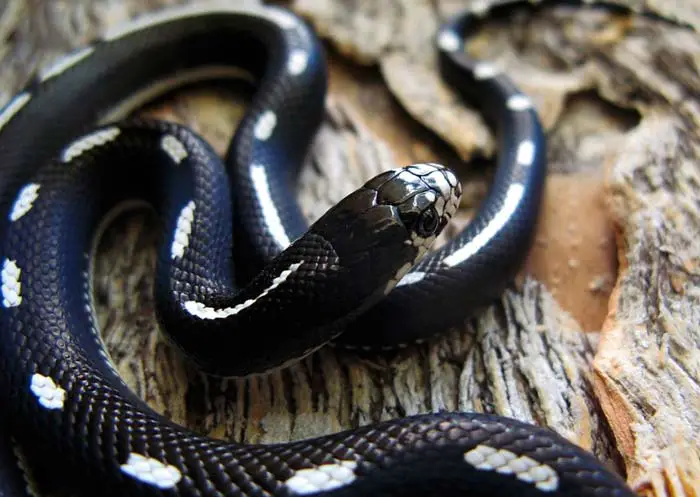
The eggs will hatch in about 60 to 70 days. Do not let the eggs hatch in her enclosure as she will cannibalize the hatchlings and even possibly the eggs before they hatch. Rather remove the eggs gently as she lays them.
Keep your eggs in a moist container between 75°F and 85°F. The baby snakes have an egg tooth that they will use to slit their eggs open.
Once they have done this they will sit in their egg and absorb their yolk sac.
Do not move them until they have fully absorbed the yolk sac as this has vital nutrients for them.
When they are ready, place them in individual containers because they do cannibalize.
Offer them a thawed pinky mouse at a week old. If they do not feed that week, it is okay. Try again every week until they do feed.
Conclusion
California kingsnakes (Lampropeltis getulus californiae), or Cali Kings, are docile snakes that make tremendous pets.
If you are a beginner snake-owner then the California king is the snake for you. These snakes are lovely to look at and come in a variety of interesting morphs.
They do not take up that much space and their enclosure has a pretty simple and manageable setup.
They are easy to take care of, hardy snakes. If you treat them right, you can form a bond that will last 15 to 20 years.
Good luck on your journey with your California kingsnake. We “herp” you and your Cali King have a wonderful time together!
Related:

